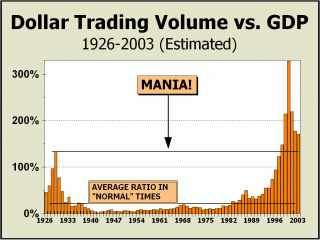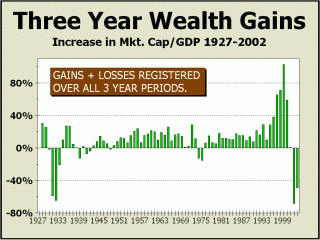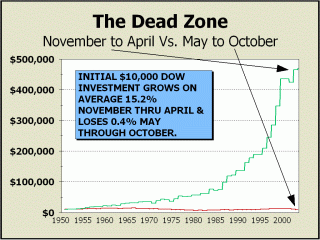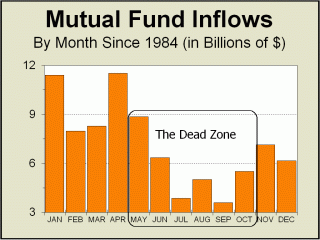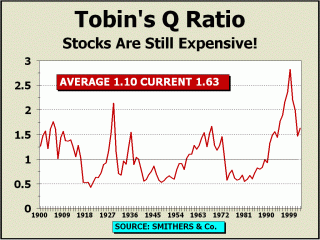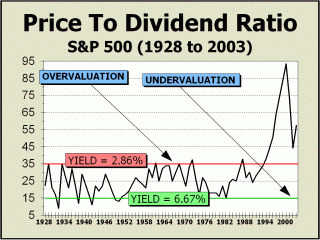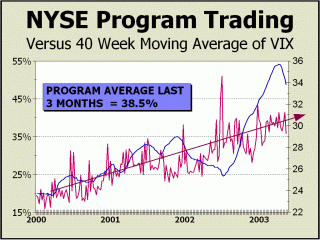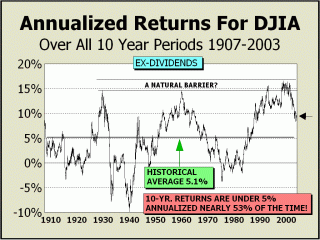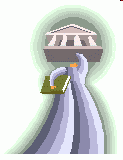
|
DATED MAY 22, 2003 A SPECIAL REPORT BY ALAN M. NEWMAN, EDITOR LONGBOAT GLOBAL ADVISORS CROSSCURRENTS |
| The May 7th
issue of Longboat Global Advisors Crosscurrents was entitled "The Matrix:
Reloaded." The title said it all. We have every reason to use
the title again for this report. The residents of the matrix continue
to be bathed in their nutrient soup and still believe they reside in a
world that does not exist; a bull market. From every angle we examine,
it seems as if the reality of the secular bear market is disrespected to
the fullest extent. Participants of every stripe are so tired of
the downside and are so eager to believe in the bull case that any excuse
is conjured up for the return of the bull. And the basic tenet utilized
for the return of the bull is that bull cycles occur in the midst of secular
bear markets. We agree but would caution that this is no ordinary
bear market. This bear follows the greatest stock market mania of
all time, greater than the South Sea Bubble, greater than the Roaring Twenties,
greater even than Tulipmania. The move up from the October &
March lows has already satisified all the parameters for a bear market
bounce. A new bull? Given the huge recent expansion in bullish
sentiment, a new bull market would appear to be a remote possibility....but
that is the preferred mode in the Matrix.
We were hoping to present a fully updated and totally accurate picture of Dollar Trading Volume in this report, but Nasdaq's budget problems are still an obstacle. As a result, their statistics department continues to work at a snail's pace and has only compiled data through October 2002. In lieu of their offer to assist us for the princely sum of $100 per hour, we decided once again to go with our own estimates, as we have done several times in the past. Typically, when we have been forced to do the estimates ourselves, we turned out to be within 2% of the actual totals, so we are fairly confident that our methodology works. But we are offering no guarantees on accuracy. As of last week and extrapolated through the end of the year, DTV comes in at 170.7% of GDP, down nominally from last year's 177.2%. Thus, for every dollar Americans spend on goods and services, $1.70 in stock is traded on our stock exchanges. It is no wonder that economic numbers are still punk. For the seventh year running, the stock market is more important than the economy. The mania continues to rage on. Excluding the prior mania years of 1928-1929 and 1996 to date, the average for DTV is a mere 19.5% of GDP. This means that trading activity is almost nine times "normal." Let's repeat that.... Trading activity is still almost nine times "normal." Even though present activity is down from the peak 328% registered in the year 2000, the current read is still higher than every other year except 1999-2002. Despite the horrific bear market that at its very worst tore 78% from Nasdaq and cut the S&P 500 in half, investors are not yet giving up and continue to trade as if the bull had never gone away. Meanwhile, stock market wealth losses remain in territory resembling only one other period, 1931-1932. Although the Dow more than doubled from the 1932 low to the 1933 high, we must remind the 1932 low was 89% down from the 1929 highs, far greater than the loss of the S&P in the present mania. And although the Dow rallied an amazing 353% from its 1932 low of 42.44 to a high of 192.40 in March 1937, it was still 49% below the 1929 high and remained below that high until late in 1954! Bulls are now counting on the market to respond as it did from the 1932 lows into the 1933 high. But in this bear market, prices never fell anywhere near as much as they did in 1929-1932. Inferring huge gains today simply because prices have gone down "far enough" and for "long enough" just doesn't constitute a logical analysis. Although the losses in wealth in the present period are not quite as fearsome as they were after the Roaring Twenties imploded, they are nevertheless substantial enough to infer that "bull market" gains must still leave the major averages well below their prior peaks. As of today, the Dow stands 27% below the peak. As of today, the S&P 500 is 41% below the peak. As of today, Nasdaq stands 70% below the peak. Logically, we can't imagine why we should look for greater gains than those already in hand. Bulls are now counting on the market to respond as it did from the 1932 lows. History may rhyme, but it does not necessarily repeat exactly. Prices are much closer to their peak now than they were at the 1933 highs!
Most of the following portion of our report first appeared in the April 28th issue of Longboat Global Advisors Crosscurrents: It's 'that' time of year again. We call it the Dead Zone, which seems an apt appellation for the half of the year in which stocks have not only not made money for investors over the last 50-odd years, but have actually lost money. It's one of Wall Street's dirty little secrets that no one in the industry wants to admit since admission of the circumstances would be simply horrible for business. Nevertheless, the facts are routinely ignored by the residents of the Matrix. It is a fact that $10,000 invested in the Dow since 1950 during the months May through October is now worth only $9056, an annualized loss of 0.4%. Of course, the reason why folks in the Matrix can be so easily persuaded year after year to go for the gusto and keep their money in for all 12 months is that the same $10,000 invested during November to April has grown to $459,917, an annualized clip of 15.2%. We have postulated several times before why this phenomenon exists and have cited a number of factors, including year end bonuses and IRAs. In the case of the former, they can be anticipated and acted upon before the end of the year although one would expect the major portion of bonus money to be invested in January, immediately after receipt. In the case of the latter and an April 15th deadline for investment, there is no question that IRAs have impacted mutual fund inflows. And guess what? The months of January and April represent the months in which mutual funds inflows have been the greatest dating back to October 1984. No one has ever shown the chart of net inflows broken down by month before. Since 1984, 62% of all mutual fund inflows have occurred in the period of November to April, incontrovertible proof that leaving money in stocks throughout the Dead Zone of May to October leaves an investor without an important impetus for continued price gains, namely demand. January and April together are responsible for an astounding 26.8% of all mutual fund inflows. Both months garner roughly 83% higher inflows than all other months. Worse yet, as we noted last year, "there is a clear distinction between secular phases for the Dead Zone. If the current bear market plays out anywhere near like it did from 1966-1982, the Dead Zone will provide a very costly experience for investors. And in reality, the results are far worse than they appear. Monies invested solely during the Dead Zone from 1966-1982 fell by a resounding 54.2% but that was before the effects of inflation. With inflation factored in, the constant dollar loss was a whopping 84.6%! Consider that when the folks on Wall Street tell you to be invested all year round. To equal the total loss of the prior secular bear market, the Dead Zone will have to provide an additional 33.7% decline in price, not including the effects of inflation. Also consider how many times you have been told that market timing does not work. What a crock! All one needed to do over the course of the last 50-odd years was to make two investment decisions each year in order to outperform every mutual fund ever created. Market timing is not a panacea and not a guarantee but it works as well as any method we have ever encountered. Meanwhile, every mutual fund in existence has never acknowledged that approach - quite the opposite. Imagine the irony of quoting returns for 1, 3, 5 and 10 year periods without ever acknowledging that half of the specified time, their own investments did nothing. Given that the average mutual fund has lost 38% over the last three years, it would appear that just throwing money into equity mutuals has very limited value as a viable investment strategy. We'll stick with market timing and the potential
to profit at all times,
The residents of the Matrix believe stocks are undervalued. How else can you account for so many proclaiming a new bull market? So, are stock prices undervalued? According to Tobin's Q Ratio, the answer is a resounding "NO!" The ratio is simply a perspective of how expensive or cheap the entire stock market is by dividing the total market value of publicly traded corporations by the total replacement cost of their assets (Source: Smithers & Co. - UK). In theory, if the ratio is above 1 it would be more profitable to sell shares to the public. If the ratio is under 1, it would be more profitable to buy corporate shares. In the long run, stocks must eventually trade at fair value so Tobin's Q is a good measure of over, fair and under valuation. Undervaluations must eventually attract buyers. Overvaluations must eventually catalyze sellers into action. For a period of 95 years up to and including 1994, Tobin's Q Ratio was dead on at an average reading of 1. To be sure, there were swings to levels way out of whack in both directions but over time, Q always reverted to the average. The stock market mania changed the equation as the residents of the Matrix were prepared to believe that almost no price was too high to pay for stocks. During the mania, "Q" soared to over 2.6! One had to be literally crazy to pay for stock assets which could far more easily be replaced by creating the same company from scratch. And of course, that is why so many companies were created and then sold to the unsuspecting public as "hot" initial public offerings that could double or triple in only one day. At the current level of 1.63, "Q" is still quite excessive. At some point, "Q" can be expected to revert to the long term average. Stocks are still way too expensive. Can dividends drive stock prices higher? Despite the plans of the Federal government to pare taxes on dividends, the limitations under consideration would ensure a minimal impact on prices. However, if dividends were to grow rapidly to levels seen in the past, perhaps stocks would be viewed far more attractively. But stocks in the S&P 500 already pay out 60% of their earnings as dividends, far more than the historical average and it is far more reasonable to expect that dividend yields can only rise if stock prices fall. Given six months of the year are a virtual Dead Zone for investors, only hefty yields can coerce investors their best policy is to sit still and not stampede out of stocks. A paradox. Only higher yields will keep investors in but higher yields will most likely occur only when investors get out. Best bet? Perhaps we should consider a mix and postulate dividend increases of 10% per year for the next five years. At that rate, a move back to traditionally overvalued (not undervalued) levels will still result in the SPX at 926, basically a sideways drift from today. Considering that the definition of overvalued comprises 87% of all premania years, we're not asking for much, are we? A move to halfway between over and under valuations would result in a decline to 662. A move to traditionally undervalued levels? Don't ask! Meanwhile, what are the odds of dividends rising at the rate of 10% a year for the next five years? Perhaps slimmer than the residents of the Matrix realize. Remember, dividends are now equal to 60% of S&P earnings. If dividends rise, earnings must rise as well. If dividends are to rise by 10% per year and the payout ratio is to fall to a more normal 50% of earnings, earnings will have to surge by a pretty steep 13.9% per year. That could be a real stretch in an economy where GDP has grown by an average of only 5.3% annually over the last 20 years. In our view, the more likely prospect is
that despite any tax break,
Program traders; more residents of the matrix. Program Trading has apparently given us the most volatile market in 67 years. Despite lower short term volatility numbers in recent weeks, as programs take a larger share of trading on the New York Stock Exchange, longer term volatility has increased sharply over the last few years. It is very troubling that the VIX and programs continue to climb together! The stock market has truly morphed into something grotesque and no longer resembles the capital formation system of yesterday in any way, shape or form. We commented on this subject extensively after the Crash of '87 and program trading has been a subject of continued interest since. Program trading was at much lower levels a decade ago, about 15% of total New York Stock Exchange volume. But over the last few years, programs have expanded significantly and are now averaging 38.5% of daily volume, affecting better than three of every eight shares traded. Although programs do not represent index arbitrage to any significant degree, they are nevertheless, of sufficient size to move the markets rapidly. Why so many programs? It is not difficult to see how or why funds like the $59 billion Fidelity Magellan prefer programs. Magellan's cash position is probably somewhere around $1.8 billion as of this moment. If fund manager Robert Stansky deems it time to invest a bit more, rather than go into the market and buy one favored issue and then another, perhaps it might make more sense to buy a "basket" of securities that closely replicate the market? The money gets invested sooner and perhaps more cheaply than otherwise. If only 5% of Magellan's cash is expanded in this manner, a $90 million program hits the floor of the NYSE and is executed in short order. A basket is defined as a minimum of 15 stocks. Let's assume a particular "basket" comprises all of the Dow 30. To spend $90 million, one would have to buy 72,629 shares of each Dow issue. Thus, $90 million can move prices quite rapidly! Programs proliferated in 1987 and coincidence or not, volatility soon expanded to the worst of all time. Is it happening again? The stock market is no longer a proper place for small investors. Why is this procedure so anathema for investors? One simple reason is that since programs can move prices so rapidly, the effect makes the concept of "current price" undependable. We are astonished that the New York Stock Exchange has allowed programs to proliferate to this extent. Where does it end? 50% of total trading volume? 70%?! 90%?!!! In every update, we attempt to afford our readers a reasonable view of where long term prices are headed. Of course, there can be no guarantees that our methodology works and we could conceivably be way off the mark. However, we are using history as our guideline and if history is meaningful (as it should be), then at least we are presenting a logical perspective. As it now stands, 10 year returns for the Dow ex-dividends are down sharply from their all time record high of 16.6% in May 1998. Are they down sufficiently? Given that 10-year returns have averaged 5.14% back to 1907, it would appear a return to "normal" would require a lot more bear market. In fact, remove the influence of the mania from 1995 to date and the average return drops to only 4.37%! A return to "normal" can be accommodated in either of two ways, price or time. Rather than impute further losses for this bear market, we choose to examine "normal" as defined by time. Assuming the Dow trades sideways from the May 16th close of 8678, the 10-year return will finally revert to "normal" towards the end of January 2006 and will fall to zero percent close to five years from today, more than nine years after prices peaked. Since 10-year returns are under 5% more
often than not,
As New York's Attorney General Elliot Spitzer has recently shown, there are many Agent Smiths on Wall Street, intent upon keeping investors in the dark. Merrill Lynch Chairman Stanley O'Neal says, ".... our industry did not create the bubble..." The blame is laid squarely at the public's feet for being so naïve and trusting. And in commenting on the $1.4 billion fraud settlement, Morgan Stanley Chairman Phillip J. Purcell glosses over ethical realities of capitalism as if they are a nuisance. Have financial firms constructed a dream world Matrix for investors? If not, why can't Wall Street's top managers admit to the role they played in sacking investor's trust? If not, why have strategists not admitted their error in continuing to forecast much higher prices all throughout the bear market? If not, why cannot professionals admit that for more than 50 years, virtually half of the time, investors were better off out of the market? If not, why do financial firms still maintain their bull stance when so many stocks are so clearly overvalued? If not, why has Wall Street allowed the proliferation of Program Trading, which places the small investor at a tremendous disadvantage? Why cannot Wall Street admit to the truths
of the long term,
Sentiment in recent weeks has been jostled, swayed and pushed by participants, eager to believe in the easiest and most comfortable scenario, rather than the tough and more likely scenario. Even newsletter writers are the least bearish they have been since January 1992. The Matrix has been reloaded. The mania continues.... Note: this report is a bit shorter than we are used to presenting but the demands on our time have only increased as the years pass. It is our intent to cut back modestly on the free content presented on our website and to concentrate more on the materials we offer to you, our valued subscribers. We have made some slight adjustments to our targets. Our forecast for 2003
places the highs (print basis) for the year at:
Our forecast for 2003
places the lows for the year at:
THE CONTENTS OF THE ENTIRE WEBSITE ARE COPYRIGHT 2003 ALAN M. NEWMAN Alan M. Newman, May 22, 2003 All information on this website is prepared from data obtained from sources believed reliable, but not guaranteed by us, and is not considered to be all inclusive. Any stocks, sectors or indexes mentioned on this page are not to be construed as buy, sell, hold or short recommendations. This report is for informational and entertainment purposes only. Longboat Global Advisors, Alan M. Newman and or a member of Mr. Newmanís family may be long or short the securities or related options or other derivative securities mentioned in this report. Our perspectives are subject to change without notice. We assume no responsibility or liability for the information contained in this report. No investment or trading advice whatsoever is implied by our commentary, coverage or charts. |
